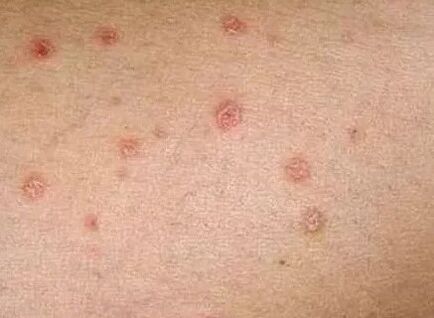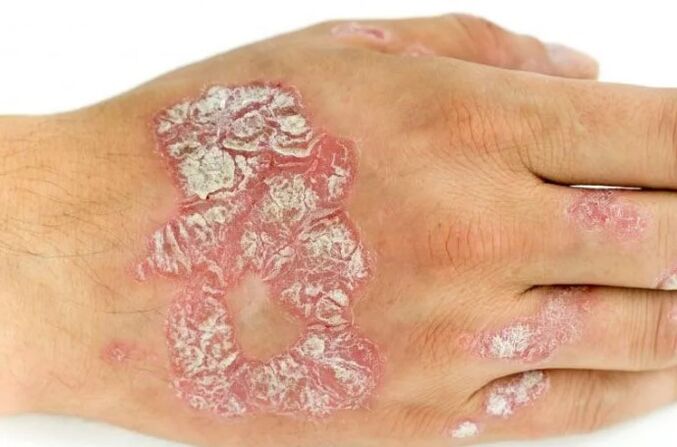Despite the fact that the unknown etiology of psoriasis and the provoking factors are well examined.Classification of psoriasis at the stage facilitates the evaluation of the course of the disease, promotes the sensitivity of the treatment method and the determination of patient tactics.

The stage of psoriasis is classified depending on the nature of aggravation (or inflammation) and severity.
Stages of psoriasis depending on aggravation
Psoriasis is a disease with 3 stages:
- progressive;
- constant;
- Retrogressive;
- remission.
Symptoms of progressive stage
This stage is characterized by obvious signs of aggravation.Several rashes appear on the skin, in the form of red lumps (papules, tubers), oval or rounded.Focus, which occupies a large area, are actively peeled and the patient experiences severe itching of the skin and sometimes burning sensations.Itching can be exhaustive and disturbed by the patient, not only in everyday life, but also in a dream, itching to increase when we are in contact with clothes.After delaying the scales, the surface may be wet and can be transformed into nutrients to spread the bacteria.
The main manifestation of the progressive section is as follows:
- Appearance of papules on the longer surface of the limbs and body;
- Melting the papules into conglomerates ("plaques"), whitish;
- peeling of conglomerates;
- There is no scales in the region of the plaques, but there is a hyperemic rim;
- The edges of the plaques are compacted;
- The presence of the kebner phenomenon: When the uninhabited skin occurs mechanical damage (cutting, scratching), a new psoriatic plaque is formed.
The more intense in the progressive phase, the redness of the skin, the more active the process of inflammation.The most dangerous consequence of psoriasis is psoriatic arthritis, while severe joint pain occurs, resulting in deformation of the joints.

Symptoms of standing stage
With the formation of a stationary stage, the aggravation process is gradually dampened.At the same time, the papules are pale and become pink from red, and during this period the new rashes do not appear.The surface of the lumps has a "plaques" shape, dense, covered with bark, represented by many dried skin scales.The healing of the papules begins from the center to the periphery.The presence of the stages of psoriasis confirms the efficiency of the treatment.
The main manifestation of this section is as follows:
- lack of rash of new papules;
- Existing plaques stop growth;
- The surface of the plaques is covered with balance;
- The red rim disappears around the fluffy plaques;
- Kebner's phenomenon disappears.
Symptoms of the regression stage
In the regression phase, the process is invision.The "plaques" are dissolved and forms of skin depigmentation.Itching of the skin gradually disappears, signs of reduction in peeling.
Signs of psoriasis regression:
- There is a voronov edge around the plaques (dense ring visible folds located around psoriasis plaques);
- reduction and gradual disappearance of peeling;
- The plaques are formed by the (white or dark) areas of depigmentation.
During the regression phase, plaques disappear completely, and plaques are possible in the area: knee, elbows, abdomen, buttocks.
Emission
Remission is a phase of apparent healing.During remission, psoriasis is in "sleep" but does not disappear from the body.Psoriasis remission lasts until the next worsening (progressive stage).

It should be noted that during the worsening of psoriasis, the general condition of the person does not change, goes to work and is involved in familiar household matters.Psoriasis only causes aesthetic and cosmetic mistakes for people: the patient's skin is scratched much, one cannot wear open clothes if they are detected in the summer, one cannot visit the pool, massage, cosmetic procedures, etc.
Stages of psoriasis depending on the area of the lesion
The severity of psoriasis also depends on the area of skin injuries.So, at a mild stage, it affects only 3%of the skin surface, with an average of 3-10%and heavy-more than 10%.Psoriasis, which causes damage to the joints, belongs to a severe extent, in which case the area of skin injuries is not taken into account.You can measure the area of the damage.For this purpose, the rule of the open palm should be used (1% of the entire body area of the human palm area).
Guy index
The overall system of assessment of psoriasis severity is evaluated using the PASI index, which includes the evaluation of prevalence and severity and the severity of the disease.This pointer is estimated from 0 to 72.At the same time, a slight indicator of psoriasis is less than 10, the average -from 10 to 20, the heavy -over 20.The use of the PASI index also calculates the clinical efficiency of treatment.
Outside the various stages, psoriasis can be different types: seborrheic, exudative, plantar, intriginous, old, rupioid, stopped, nails and mucous membranes psoriasis.It is impossible to fully cure psoriasis, but it can achieve a long remission.This goal is performed by modern treatment methods.























